YETRAC
Ferguson-Brown Company: Pioneering Agricultural Machinery and the Birth of a Legacy
Ferguson-Brown Company: Pioneering Agricultural Machinery and the Birth of a Legacy
Founded: Early 1930s Founder: Harry Ferguson Industry: Agricultural machinery Key Product: Ferguson-Brown Model A tractor Merger: Massey-Harris-Ferguson
The Ferguson-Brown Company, a British agricultural machinery manufacturer, played a pivotal role in shaping the modern farming landscape. Founded in the early 1930s by Harry Ferguson in partnership with David Brown, the company introduced groundbreaking innovations that revolutionized farming practices and led to the birth of iconic tractor models.
The Model A Ferguson-Brown Tractor
One of the most significant contributions of the Ferguson-Brown Company was the development of the Model A Ferguson-Brown tractor. This tractor was a game-changer for farmers, thanks to its innovative hydraulic three-point linkage hitch, designed by Harry Ferguson himself.
The Model A tractor featured a Coventry Climax Model E engine in its early versions. However, as the production progressed, engine manufacturing was taken over by David Brown Ltd., leading to several improvements. Notably, David Brown’s modifications included a deeper sump to address issues of oil starvation during hillside work. Surviving examples indicate that this engine transition occurred around serial numbers 525 to 528.
The Agreement with Ford
In 1938, Harry Ferguson struck a handshake agreement with none other than Henry Ford to produce the Ferguson System Ford-Ferguson tractors. These tractors incorporated Ferguson’s revolutionary self-regulating three-point hitch system. The partnership began with the production of the Ford-Ferguson 9N tractor, featuring the iconic blue Ford emblem on the front of the hood and the Ferguson System emblem on the grill.
The three-point hitch quickly gained popularity among farmers in North America and around the world. This system also included a rear Power Take Off (PTO) shaft, allowing the operation of three-point hitch-mounted implements like sickle-bar mowers. The location of this PTO set the standard for future tractor developments.
The Agreement with Standard
In December 1945, the Standard Motor Company Limited announced its arrangement to manufacture Ferguson’s tractors. Standard’s factory at Banner Lane in Coventry, newly acquired, would serve as the production site. These tractors were intended for the Eastern hemisphere, while Ferguson tractors built by Ford in America were designated for the Western hemisphere. Production was anticipated to commence in 1946 after the conversion of the former WW2 aircraft factory. Implements would be sourced and sold separately by Ferguson.
Split with Ford and the Postwar Era
The relationship between Harry Ferguson and the Ford Motor Company eventually soured, leading to a split in 1946. A series of disagreements and a protracted lawsuit followed, centering on Ford’s continued use of Ferguson’s patents. Although Ford altered the hydraulic design of its postwar tractors to circumvent Ferguson’s hydraulic system patent, it continued to produce tractors equipped with the basic Ferguson hitch arrangement.
The postwar Ford 8N, featuring Ferguson’s three-point hitch, went on to become the top-selling tractor of all time in North America.
The Birth of the Little Grey Fergie
After parting ways with Ford, Harry Ferguson saw an opportunity to collaborate with the Standard Motor Company in the UK to produce a new design: the Model TE20. Often affectionately referred to as the Little Grey Fergie, this tractor became iconic.
The “TE” in TE20 stood for Tractor, England, and the number 20 indicated its horsepower (15 kW). The Model TE20 featured several variants, starting with the TE20 equipped with an imported Continental Z120 engine. In 1948, the TEA20 was introduced with a Standard-brand petrol engine, followed by the TED20, which ran on TVO (tractor vaporizing oil, similar to paraffin). A diesel model, the TEF20, was also introduced. Specialized variants, such as the TEB20 and TEC20, with narrow tracks for vineyard and orchard work, were also available.
The success of the Little Grey Fergie was nothing short of remarkable, with over 500,000 units produced between 1946 and 1956. Its global appeal led Ford to nickname it the “Grey Menace”, and its robustness was demonstrated when a fleet of these tractors was used during Sir Edmund Hillary’s expedition to the South Pole in 1958.
Ferguson’s Innovations
Harry Ferguson’s contributions extended beyond tractors. His designs introduced several groundbreaking features, including:
- Single-wheel brakes: These allowed for sharp turns by braking the inside wheel.
- Four-speed gearbox: The TE20 was among the first tractors to feature a four-speed gearbox with an integrated differential.
- Hydraulic system: The Ferguson System’s three-point linkage revolutionized farming practices, making tractors safer and more efficient.
Merger with Massey-Harris
In 1953, Harry Ferguson’s company merged with Massey-Harris, forming the Massey-Harris-Ferguson conglomerate, later shortened to Massey Ferguson. This merger solidified the legacy of Ferguson’s tractors and designs. By this time, many tractor manufacturers had developed their own three-point linkages, and this system had become standardized worldwide.
Harry Ferguson’s pioneering spirit and innovative contributions to agriculture continue to influence the farming industry to this day. The Ferguson-Brown Company’s legacy lives on through the enduring impact of the Little Grey Fergie and the revolutionary Ferguson System. Harry Ferguson’s vision, collaboration, and relentless pursuit of excellence transformed the world of farming, making it more productive, efficient, and safer for generations of farmers.

